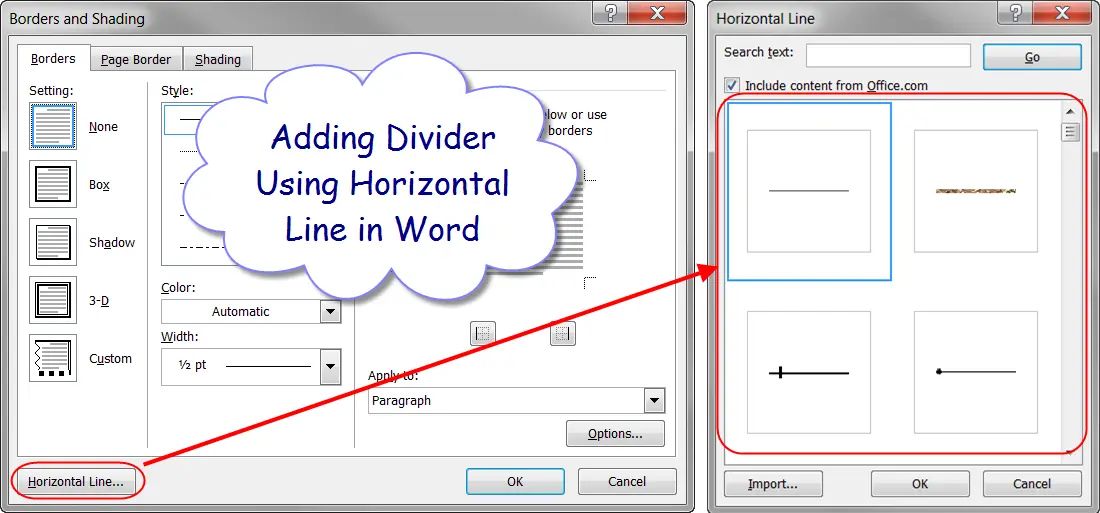There are many word processing tools available but once worked in the comfort of Microsoft Word, you may not like any other software. It is pretty sure no one exactly knows the complete features Word offers. Adding dividers is one such hidden features and you can do this with shortcuts. In this article we will show how to add dividers in Microsoft Word documents quickly.
Related: How to fix slow Microsoft Word and speed up you productivity?
You can add dividers with different methods.
- Use hyphen and underscore
- Using other symbol shortcuts
- Insert image as divider
- Insert from the menu
1. Using Hyphens and Underscores
The simplest and most easy method is to use continuous hyphens and underscores. You can continuously press hyphen or underscore to insert the divider line between paragraphs. The advantage is that you can define the length and alignment of the divider as per your need.
- Divider using hyphens: —————–
- Divider using underscore: ____________
2. Quick Way to Add Dividers with Shortcuts
When you want to insert a full width divider between two sections or elements, you can use the following shortcuts.
- Press hyphens for three or more times and press the enter key (— and ⏎). This will create a full width divider as a thin continuous line.
- Press three asterisks and enter (*** and ⏎) to if you want a dotted line.
- Use three equal signs and enter (=== and ⏎) to add a double line.
- Use three underscores and enter (___ and ⏎) to make a divider with medium thickness.
- Type three number signs and enter key (### and ⏎) to create a thicker line with borders.
- And finally with three tildes and enter (~~~ and ⏎) to create a wavy divider line.
Below picture explains the shortcut keys and the display of the divider in Word document.
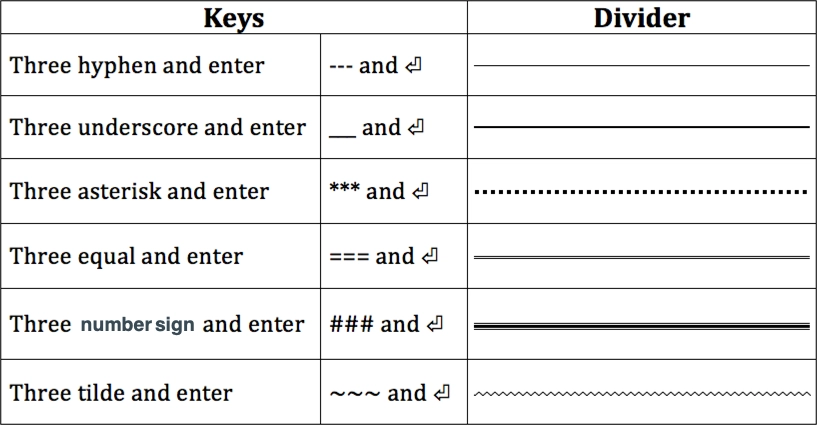
Deleting Dividers Inserted with Shortcuts
Well, you have created the dividers using the above shortcuts and now is the time to see how to delete them. You may find it difficult to delete since those dividers are not actually lines – they are bottom borders act like an underline. In fact, you can simply click on the “Borders” icon to insert divider in Word. Since “Borders” option by default uses “Bottom Border” clicking on it will insert a line similar to the above shortcuts. Follow the below instructions in order to delete the dividers.
- Position your cursor on the previous line of the divider. If you have an element like paragraph before the divider then select the paragraph.
- Click on the “Home” tab and then click the small arrow next to “Border” button in the “Paragraph” group.
- Select “No Border” or “None” option from the list.

This works on all Word versions like 2019, Microsoft 365, etc. on all platforms like Windows 10 / 11. This also works on Microsoft Word for Mac.
3. Using Images for Dividers
Using image is another option to insert divider image on your Word document. You can create suitable images and insert between elements as an object. Remember, not to copy image from website and paste on your document. Word will take long time to extract the image and also link the image to the webpage from where you are copying. The best option is to right click and save the image to your computer. After that, you can either copy paste from local computer or insert the image from menu.
4. Using Horizontal Line as Divider
The last option to insert divider in Word documents is using horizontal line menu option available. You can access this option under “Paragraph” group in “Home” tab. However, this option varies in Word 2016 onwards and earlier versions.
Word 2010 or Earlier
- Click on the “Borders and Shading” button and click on the “Horizontal Line” option to insert a divider on your document.
- If you want to insert a fancy divider, choose the menu option click on the “Horizontal Line…” button. On the popup box, select the divider style you want to insert.
Word 2016 or Later
- If you use Word 2016 or later versions like Microsoft 365, click on the small arrow next to “Border” icon. This is available in “Paragraph” group under “Home” menu.
- Choose “Horizontal Line” option to insert a grey color divider line.
- Double click on the divider to open the “Format Horizontal Line” pop-up.
- Choose the color, alignment, width and height for your divider.
- Unlike dividers inserted with shortcuts, you can move the horizontal lines by dragging it to required place in your document.
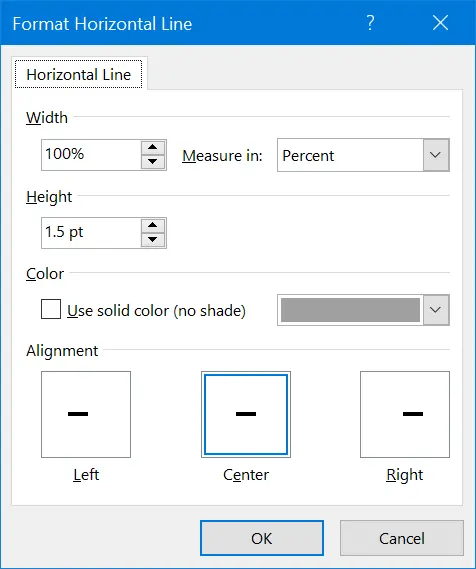
Horizontal line is a perfect option for inserting dividers in Word and it will also work on Word Microsoft 365 subscription in Mac also. However, double clicking on horizontal line in Mac Word will open “Format Shape” options in the sidebar. You can go to “Shape Options” tab and start customizing the color, thickness and other styles of the line.
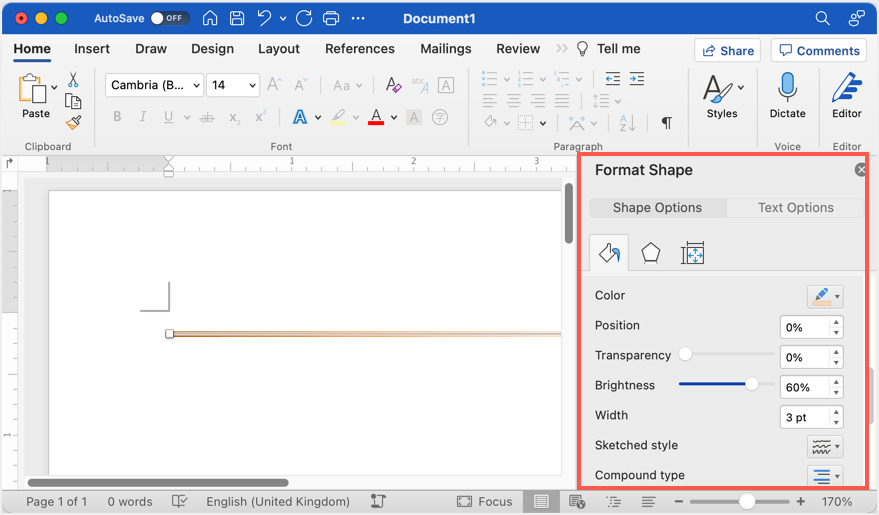
Microsoft Access Divide Word documents into sections using horizontal lines
- Put your cursor in the document where you want to insert the horizontal line.
- Go to Format | Borders And Shading.
- On the Borders tab, click the Horizontal Line button.
- Scroll through the options and select the desired line.
- Click OK.
Contents
- 1 How do I insert a dividing line in Word?
- 2 How do you insert a vertical dividing line in Word?
- 3 How do you insert a horizontal line in Word?
- 4 How do I divide a Word document into 4 sections?
- 5 How do I split a Word document into 8 sections?
- 6 How do I split a Word document into 3 sections?
- 7 What are the 4 types of section breaks?
- 8 How do you type a pipe on a keyboard?
- 9 How do you put a vertical line in text?
- 10 How do I split a Word document into chapters?
- 11 How do I split a Word document into horizontal sections?
- 12 How do I split a Word page into two rows?
- 13 What’s a section break on Word?
- 14 How do I edit sections in Word?
- 15 Why can’t I select a section break in Word?
How do I insert a dividing line in Word?
Click the “Insert” tab. Click the “Shapes” button on the ribbon and choose the “Line” option, the first one in the Lines subcategory. Press and hold down the “Ctrl” key, which keeps your divider line straight. Position the cursor near the left margin under the place you want to divide.
How do you insert a vertical dividing line in Word?
To add a vertical line using the shape tool, go to Insert | Shapes and select the Line tool. Place the cursor where you want the line to start, and drag to where you want the other end of the line to be. Holding the Shift key while you drag will ensure that the line is straight.
How do you insert a horizontal line in Word?
Use the Horizontal Line Tool to Insert a Line in Word
- Place the cursor where you want to insert a line.
- Go to the Home tab.
- In the Paragraph group, select the Borders drop-down arrow and choose Horizontal Line.
- To change the look of the line, double-click the line in the document.
How do I divide a Word document into 4 sections?
To split a page to 4 parts, you can insert a table to deal with the job.
- Place the cursor at left-top of the page, then click Insert > Table, select 2×2 Table.
- The table has been inserted, then drag right-corner of the table to resize it as you need.
- Insert texts into the columns and rows separately.
How do I split a Word document into 8 sections?
Divide a Document into Sections
- Place the insertion point where you want the section break.
- Choose the Page Layout tab.
- Click the down-arrow next to the Breaks button. A menu appears.
- Click the type of section break you want. Word inserts the section break.
How do I split a Word document into 3 sections?
Word 2016 & 2013: Divide Page Into Columns
- Highlight the text you wish to split into columns.
- Select the “Page Layout” tab.
- Choose “Columns” then select the type of columns you wish to apply. One. Two. Three. Left. Right.
What are the 4 types of section breaks?
The different kinds of section breaks include next page, continuous, even page, and odd page breaks.
How do you type a pipe on a keyboard?
On English PC and Mac keyboards, the pipe is on the same key as the backslash key. It is located above the Enter key (Return key) and below the Backspace key. Pressing and holding down the Shift while pressing the | creates a pipe.
How do you put a vertical line in text?
You can type a straight vertical line, or “|,” on most modern keyboards dating back to some of the 1980s IBM PCs. It’s generally found above the backslash, so you can type a “|” by holding down the shift key and hitting the “” key.
How do I split a Word document into chapters?
New chapter
- Click where you want to insert the new chapter heading and insert a page break (see Section and Page Breaks).
- In the Styles Pane, click Heading 1 style. The word “Chapter” and the chapter number will appear.
- Click after the chapter number and enter the text for the chapter heading.
How do I split a Word document into horizontal sections?
Divide Word documents into sections using horizontal lines
- Put your cursor in the document where you want to insert the horizontal line.
- Go to Format | Borders And Shading.
- On the Borders tab, click the Horizontal Line button.
- Scroll through the options and select the desired line.
- Click OK.
How do I split a Word page into two rows?
Split a table
- Put your cursor on the row that you want as the first row of your second table. In the example table, it’s on the third row.
- On the LAYOUT tab, in the Merge group, click Split Table. The table splits into two tables.
What’s a section break on Word?
Section breaks are used to divide the document into sections. Once section breaks are inserted, you can format each section separately. For example, format a section as a single column for the introduction of a report, and then format the next section as two columns for the report’s body text.
How do I edit sections in Word?
Change a section break
- Click or tap in the section break you want to change.
- Go to Layout and select the Page Setup launcher button .
- Select the Layout tab.
- Select a new section type from the Section Start drop down list.
- Select OK.
Why can’t I select a section break in Word?
There are several methods which should work: Place the cursor at the beginning of the Section Break then press del in the Numeric Keypad if your keyboard has one. If not [as with a laptop] press fn+delete. Place the cursor at the beginning of the Section Break, press Shift+➡︎ then press delete.
Corralling information in a Microsoft Word document isn’t all about headers and paragraph formatting. You may find yourself needing to draw a line in the virtual sand, and with Word, all you need to do is tell it where and how. Word’s Shapes collection lets you make horizontal and vertical lines to separate content on your pages.
Using a Word Separator Symbol
Inserting a symbol between words is a great way to make a heading predominant or to keep words separate for readers who are quickly scanning a document. Instead of using hyphens or asterisks, try using an ASCII or Unicode (hex) symbol as a word divider, available inside Microsoft Word.
To do this, place the cursor where you want the symbol to appear click the «Insert» menu, then select «Symbols» and then «More Symbols.» Select the one you want from the table that appears. You can also filter the list by selecting the Unicode or ASCII options.
MS Word Separator Line
Drawing a horizontal line across the page to separate paragraphs is very straightforward if you’re not too fussy about how the line appears. Just place the cursor in a blank line between sentences and hit the hyphen key several times. When you press Return, the hyphens transform into a single long hyphen.
To draw a custom line in a document to separate words, use the Shapes option. Scroll to the place on the page to place the divider. To add extra space for the divider, press the “Enter” key. Click the “Insert” tab. Click the “Shapes” button on the ribbon and choose the “Line” option, the first one in the Lines subcategory.
Press and hold down the “Ctrl” key, which keeps your divider line straight. Position the cursor near the left margin under the place you want to divide. Press and hold down the left mouse button and drag the cursor to the right, drawing the divider. Release the mouse button and the “Ctrl” key.
Click the divider line once it appears. When the new Tools tab opens, click the “Shape Outline” menu on the ribbon. Here you can format the divider by making it thicker, changing its color and choosing a different line style.
Using Clip Art to Divide Content
Microsoft Word has an extensive collection of clip art you can use to separate content on a page, including bars and scrollwork, which can add a dash of elegance to a page. To find some clip art, select «Online Pictures» from the Insert tab.
Enter a word that describes the art you are looking for. Using words like «divider,» «scrollwork,» «border» or «flowers,» should help you find the perfect artwork to divide your content.
if you’re having trouble distinguishing content from one column to another, then it can make it difficult to read a document that has employed that type of layout.
Microsoft Word includes a variety of formatting options, including one specific to columns that can help to improve this situation.
Our tutorial below will show you how to find and apply the setting that puts a line between the columns in your document.
How to Add Column Lines in Microsoft Word
- Open your document.
- Select the Layout tab.
- Click the Columns button, then choose More Columns.
- Check the Lines between box, then click OK.
Our guide continues below with additional information on putting lines between columns in Word documents, including pictures of these steps.
There are a lot of different ways that you will reformat a document based on what you are creating.
We have previously written about adding columns in Word, which is important for people that are writing articles or generating newsletters.
But the design of your document might dictate that the columns aren’t enough and that there needs to be some kind of visual separation between those columns.
You may have experimented with accomplishing this via borders or text boxes, but that can be frustrating and probably won’t create the appearance that you want.
Fortunately, you can use a feature in Word that will simply add lines between your columns automatically.
Microsoft Word has a strikethrough option similar to many other applications. Our guide on how to draw a line through text in Word can show you how to use it.
How to Place a Line Between Columns in Word (Guide with Pictures)
The steps in this article were performed in the Word for Office 365 version of the application, but will also work in earlier versions of Word as well.
Note that this guide will assume that your document already has columns.
Once you’re done with this article, find out how you can hide comments when printing in Word if you’ve discovered that it’s occurring on documents where you’ve collaborated with others.
Step 1: Open your document in Word.
Step 2: Click the Layout tab at the top of the window.

Step 3: Click the Columns button, then choose the More Columns option.

Step 4: Check the box to the left of Lines between, then click the OK button.

You should now have a document with lines between its columns, like the image shown above.
For additional information on working with columns in Microsoft Word documents, check out this how to make columns in Word Office 365 tutorial.
Matt Jacobs has been working as an IT consultant for small businesses since receiving his Master’s degree in 2003. While he still does some consulting work, his primary focus now is on creating technology support content for SupportYourTech.com.
His work can be found on many websites and focuses on topics such as Microsoft Office, Apple devices, Android devices, Photoshop, and more.
There are a few different ways to create horizontal divider lines in Word 2007 and Word 2010. The most commonly used one is done by typing three hyphens (—) and then pressing Enter:
If you want a dotted line, use three asterisks (***):
Three equal signs (===) gives you a double line:
Three underscores (___) makes a divider of medium thickness:
Three number signs (###) generates a thicker line with borders:
And three tildes (~~~) creates a wavy line:
If you ever want to delete one of these lines, you may find it tricky to remove. That’s because they’re not actually lines, they are borders. To remove one, select the line and the paragraph that precedes it, click on the Border button on theHome tab in the Paragraph group and select No Border.
The easiest way to enter an em dash ( — ) is to let Word do it. Simply enter two hyphen characters between the two words you want to connect, and Word will turn the hyphens into an em dash. If this doesn’t work for you, one of two possibilities exist:
- You’ve inserted space characters between the words and the hyphen characters. When you enter spaces between the hyphens, Word formats the hyphens as an en dash ( – ), which is shorter than an em dash.
- Someone has disabled the AutoCorrect option that formats hyphens as an em dash.
Now, this default won’t work for everyone every single time. If you occasionally need two hyphens instead of an em dash, you can press [Ctrl]+Z and Word will undo the em dash character and restore the hyphens. If you find yourself doing this a lot, it might be more efficient to disable the AutoCorrect option and enter an em dash, when you require it, manually. You can disable this option as follows:
- From the Tools menu, choose AutoCorrect Options.
- Click the AutoFormat As You Type tab.
- Uncheck the Hyphens ( — ) With ( — ) option.
After disabling the AutoCorrect option, you’ll have to enter an em dash manually. Fortunately, there are three easy methods:
- Press [Ctrl]+[Alt]+-. You must use the minus sign (-) on the numeric keypad; if you use the hyphen character on the alphanumeric keypad, Word will change the cursor.
- Hold down the [Alt] key and type 0151 on the numeric keypad.
- Choose Symbol from the Insert menu, click the Special Characters tab, highlight the em dash, and click Insert.
Entering an em dash character is easy, whether you let Word do it or you choose to enter the character yourself.
microsoft word automatically creates it when you type in two dashes — followed by a space.
alternatively, you can hold down the ALT key, and then type in 0151 on the numeric keypad to create it.
make sure to type in all four digits, not 151, but 0151.
if you want more special characters. go to windows start, click on programs, then click on accessories, and select the character map.
Microsoft Word
A great way to make your Word document easier to read and more visually appealing is to separate sections in the document by inserting a graphical horizontal line. Word provides a number of attractive graphical horizontal lines from which you can choose.
Follow these steps to insert a horizontal line in your
document:
- Put
your cursor in the document where you want to insert the horizontal line. - Go to
Format | Borders And Shading. - On the
Borders tab, click the Horizontal Line button. - Scroll
through the options and select the desired line. - Click
OK.
You can also insert your own custom horizontal lines. To insert
a custom line, follow these steps:
- Go to
Format | Borders And Shading. - Click the
Horizontal Line button. - Click
the Import button. - Navigate
to the file that contains the line you want to add and click the Add
button to add the line to the Horizontal Line Gallery. - Click
OK to add the line to the current document.
Horizontal lines are treated as any other graphic image;
they can be copied, moved, resized, and colored like any other picture object.
To format the line, right-click it and select Format Horizontal line to change
the line’s properties such as color, size, and alignment.
Microsoft Excel
Use conditional formatting to view formula cells in Excel
If you need to find and check the formulas in a Microsoft
Excel worksheet that contains hundreds of cells, you could press [Ctrl][~] to display them all at once. However, you would have to
press the shortcut keys again to see if the resulting value for the formula was
correct. You could also use the Special command under Edit | Go To: to
highlight all of the formula cells in a worksheet, but once you click on one
cell to see the underlying formula in the formula bar, the rest of the cells
are no longer selected. The method that I recommend is to use conditional
formatting to highlight the cells that have formulas. With conditional
formatting, the cells stay highlighted even after you click on one cell to view
the underlying formula.
To use conditional formatting, create a Visual Basic
function that automatically checks for formulas in cells. Follow these steps:
- Open
the Excel file containing the formulas to be checked. - Press
[ALT][F11] - Go
to Insert | Module. - Enter the following code at the
prompt.
Function IsFormula(Check_Cell As Range)
IsFormula
= Check_Cell.Hasformula
End Function - Press [ALT][Q].
- Select
the cells to be examined for formulas (e.g., select A5:H1000 with A5 as the
active cell). - Go
to Format | Conditional Formatting. - Select
Formula Is from the Cell Value Is drop-down list. - Enter
=IsFormula(A5) - Click
the Format button. - Choose
Yellow in the Color drop-down list. - Click
OK twice.
All formulas in the current workbook are highlighted in
yellow and will remain so when you reopen the workbook, as long as macros are
enabled.
Microsoft Access
Divide Word documents into sections using horizontal lines
A great way to make your Word document easier to read and
more visually appealing is to separate sections in the document by inserting a
graphical horizontal line. Word provides a number of attractive graphical
horizontal lines from which you can choose.
Follow these steps to insert a horizontal line in your
document:
- Put
your cursor in the document where you want to insert the horizontal line. - Go to
Format | Borders And Shading. - On the
Borders tab, click the Horizontal Line button. - Scroll
through the options and select the desired line. - Click
OK.
You can also insert your own custom horizontal lines. To insert
a custom line, follow these steps:
- Go to
Format | Borders And Shading. - Click the
Horizontal Line button. - Click
the Import button. - Navigate
to the file that contains the line you want to add and click the Add
button to add the line to the Horizontal Line Gallery. - Click
OK to add the line to the current document.
Horizontal lines are treated as any other graphic image;
they can be copied, moved, resized, and colored like any other picture object.
To format the line, right-click it and select Format Horizontal line to change
the line’s properties such as color, size, and alignment.
Editorial standards
Microsoft 365, Microsoft Office, Microsoft Office for Mac, Microsoft Word, Office 2007, Office 2010, Office 2013, Office 2016, Office 2019, Office 365 /
6 March 2022
Word’s ‘Line Between’ option for multiple columns can replaced and formatted to a different color or other types of line.
The downside Word’s standard line between column setting is the lack of formatting. All you can do is choose ‘Line Between’ and no more. There’s no known way to change the look of the vertical line between columns. Like the old Model T cars, your choice is black or black.
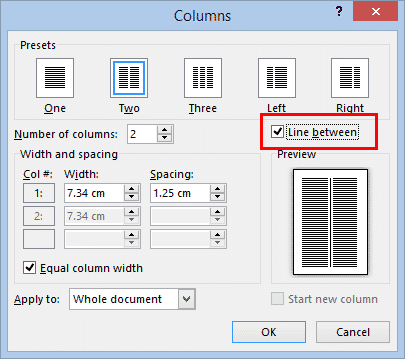
There’s a workaround. We’ll be honest telling you there are downsides with the workarounds so we’ll explain the problems you might strike.
Paragraph formatting, borders
The most flexible one is changing the paragraph formatting to include a left-hand border to paragraphs on the right column (or right-border for the left column).
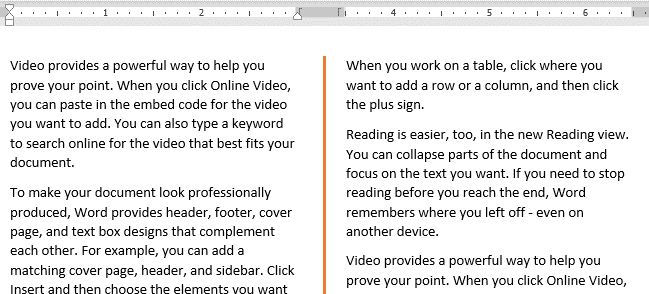
Do that from Borders and Shading | Borders | Options then increase the From text … Left (or right) so the line appears in the middle of the column.
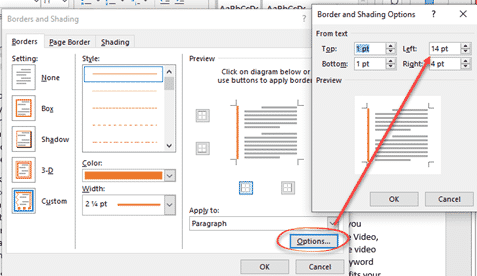
Try a setting about 14pt and adjust to suit you. Too small and the vertical line isn’t centered between the columns. Too high and the line is cut off by the adjoining column.
You’re not limited to single block lines. The Style and Width options allow a wide choice of line styles and thickness.

More than two columns
This workaround also works for more than two columns. The same border formatting applies to all paragraphs from the second column onwards.

Now, to the problems with this fix.
Paragraphs only problem and fix
Border settings work at the paragraph level. A paragraph split between two columns (like this example) adds the border line from the start of the paragraph not the top of the column.
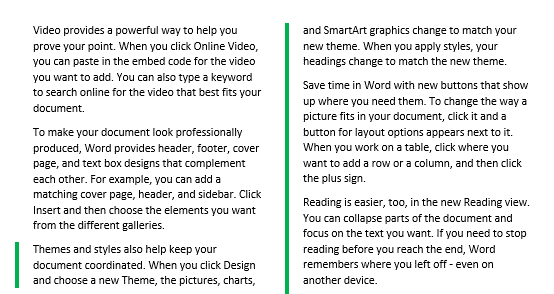
The fix is to add a column break before a paragraph. Place the cursor at the start of a paragraph then choose Layout | Breaks | Page Breaks | Column

Adding a column break can mess up the balance of the columns, leaving white space at the bottom of a column. You might be exchanging one problem for another.

Needs constant manual adjustment
Because the border formatting isn’t linked to the column formatting, any change in the document is likely to mess up your line between / border formatting.
Adding more text, as in this example, pushed text to the column top.
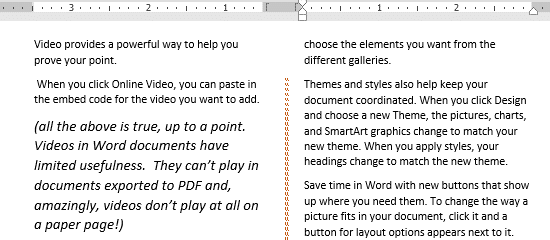
Changing page size, margins, pagination and many other things could spoil the manual paragraph border formatting you set because Word rearranges the column wrapping.
If choosing this workaround, check that the border setting is correct immediately before printing or export to PDF.
Table workaround
Another workaround is to create a table with only the vertical internal lines visible. That has the same text wrapping problems as the paragraph formatting workaround, but might suit you better. See Word tables for formatting magic
See Five ways to add vertical lines in Word
Four more vertical formatting tricks in Word
Flowing column text in Word with break-out or sidebar
Now that technology rules the world, developers are exploring various word processing tools but once you get familiar with Microsoft Word you may not like other software. No one is certainly an all know of word software, and one of the things many found difficult is insertion of dividers in words but it’s something that can be done easily.
In line with this, this content is written to provide you with every necessary procedure you need to know on how to insert dividers in word, for resume, on word 2016 or later, on Mac, etc, and I’m pretty sure you’ll find this information useful.
There are different methods to insert dividers in words but let’s quickly consider the quick way to add dividers with a shortcut;
-
Click the hyphen two or more times then press the enter button. This will give you a full-width divider as a thin continuous line.
-
Click asterisk thrice(***) and enter the key if you want a dotted line.
Use three equal signs(===) and enter a button to add a double line. -
Use three underscores(___) and enter a key to form a divider with a medium thickness.
Press three number signs (###) and enter a key to make a thicker line with a border.
And to round it up, use three tildes (~~~) and enter to make a wavy divider line.
Inserting divider in word 2016 or later
1.Users of word 2016 or later versions (i.e 2019 or Microsoft 365) can click on the arrow next to the shading bar. you can simply locate this in the symbol used to represent it down the (Section) at the top of the document on your PC at the Home menu.
2.Click on the Outside BorderSelect the Border and shading for inserting the divider
3.Select the style you want to use, color, width, and the settings bar. After you finish your editing, click ‘OK‘.
How To Add Divider/line in resumes
1.When you are hunting for a job, one of the best ways to secure yourself a place is to have a professional and easy-to-scan resume. This will get you in the door for an interview in the first place. The trick is knowing how to add lines to words the correct way.
The fastest way to add horizontal lines is via the auto-format feature.
How to use auto format to add lines to resume
1.Shift the cursor to the point where you want to add the lines.
2.Press three symbols in a row:
-( hyphen for a plain single line)
===(Equal sign for a plain double line)
***(Asterisk for a broken or dotted line)
~~~(tildes for wavy lines)
###(number sign for a triple line with a thick center).
3.Press enter to move the line, press it once and drag it to another location. And in case you want to format the horizontal line, double click on the line to open the format horizontal line box where you can amend the height, width, alignment, and the color of the line.
In addition, you can also download WPS Office software to process documents in Word, Excel and PowerPoint for free now and get more easy and enjoyable working experience.

